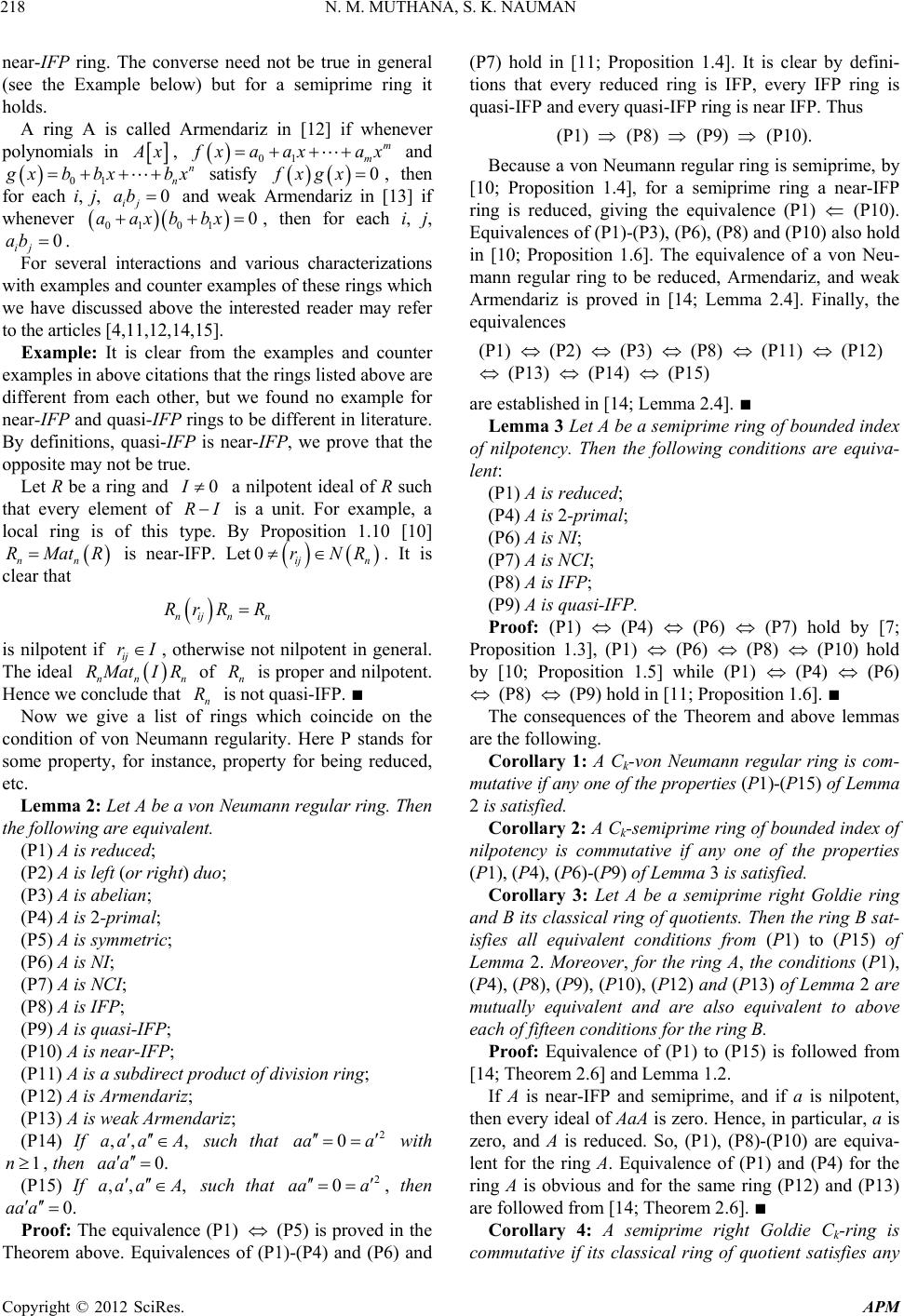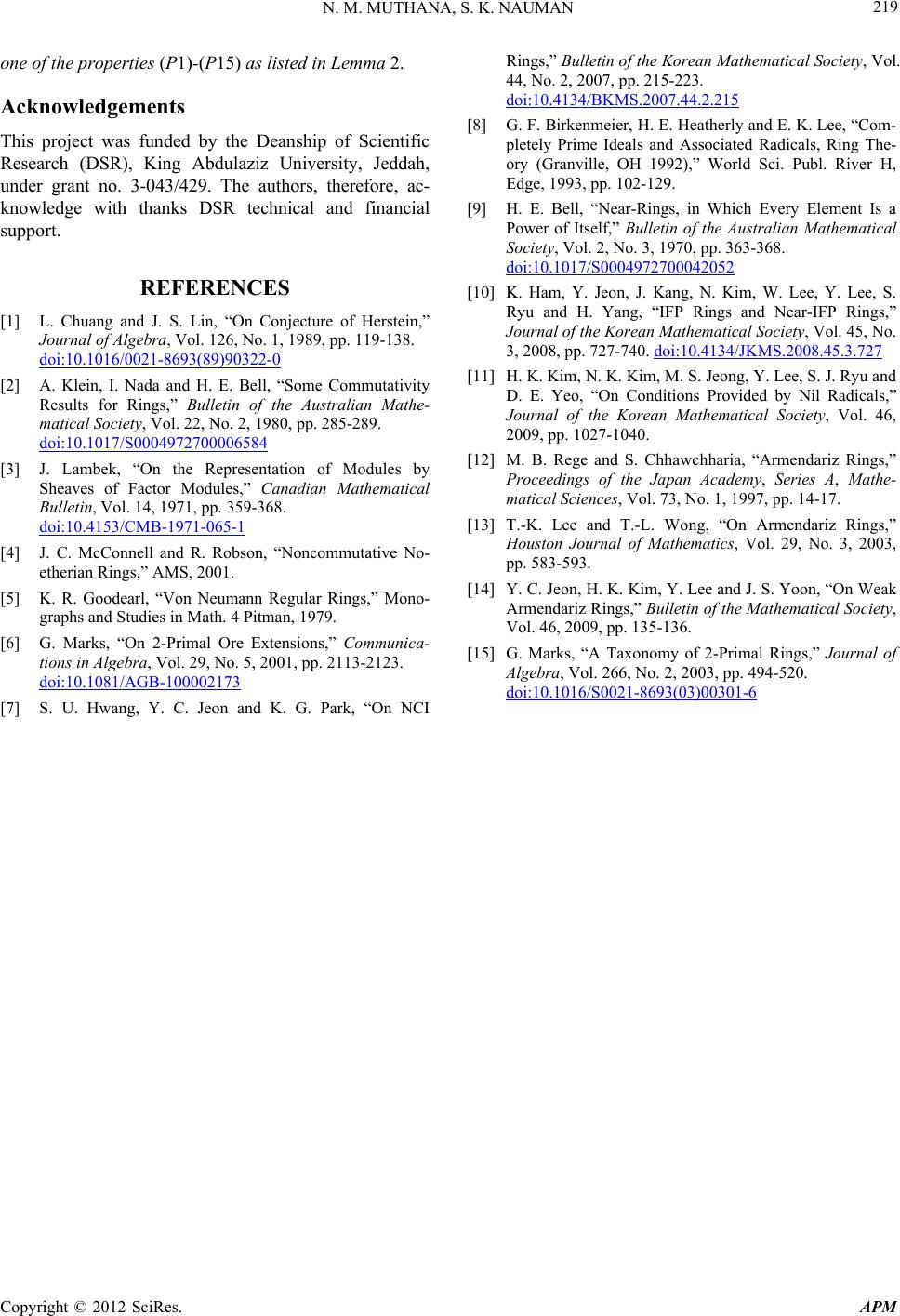 Advances in Pure Mathematics, 2012, 2, 217-219 http://dx.doi.org/10.4236/apm.2012.24031 Published Online July 2012 (http://www.SciRP.org/journal/apm) On Commutativity of Semiprime Right Goldie Ck-Rings Najat M. Muthana, S. Khalid Nauman Department of Mathematics, King Abdulaziz University, Jeddah, KSA Email: {najat_muthana, synakhaled}@hotmail.com Received December 2, 2011; revised February 5, 2012; accepted February 14, 2012 ABSTRACT This short exposition is about some commutativity conditions on a semiprime right Goldie Ck-ring. In particular, it is observed here that a semiprime right Goldie Ck-ring with symmetric quotient is commutative. The statement holds if the symmetric ring is replaced by reduced, 2-primal, left duo, right duo, abelian, NI, NCI, IFP, or Armendariz ring. Keywords: Semiprime Right Goldie Ck-Rings; Reduced; Symmetric; Von Neumann Regu lar Rings In this short note we expose some commutativity condi- tions on a semiprime right Goldie Ck-ring. All rings here are associative with an identity. A ring A is said to be a Ck-ring, as introduced by Chuang and Lin in 1989 in [1], if for very pair of elements x, y A, there exist integers m = m(x, y) and n = n(x, y) such that ,0 mn k xy , where [x, y]k is the kth-commutator defined by Klein, Nada, and Bell in [2] in 1980, as 1 ,, kk , yxy y where 1 ,, yxy. A ring is called a symmetric ring (in the sense of Lam- bek [3]), if when ever rab = 0, then rba = 0, , semiprime (respt. reduced) if A has no non-zero nilpotent ideal (respt. element) and von Neumann regular if for each a ,,rabA A, there exists r A such that ara = a. A ring is right Goldie in case it has finite right uniform dimen- sion and satisfies acc on right annihilators. In [1; Theorem 1] Chaung-Lin proved that: Lemma 1: Every reduced Ck-ring is commutative. We use it to prove the following. Theorem: A semiprime right Goldie Ck-ring with sym- metric right quotient is commutative. Proof: Lambek in [3; Section 1G] proved that every reduced ring is symmetric. We prove that the converse holds for von Neumann regular rings. In deed, one may deduce easily that A is symmetric if and only if 12 0 k aa a , then 12 0 pp pk aaa , where ai, ap(i) A and p is a one-to-one correspondence on the set {1, 2, ···, k}. Let a N(A) be a non-zero ele- ment of some index n. Since A is von Neumann regular, for some x A, 1n aaxa axa . But A is symmetric and an = 0, which implies that a = anxn−1 = 0. Hence A is reduced. The famous Goldie’s Theorem states that a ring A is semiprime right Goldie if and only if A has a right quo- tient ring B which is semisimple Artinian [4; Theorem 2.3.6]. But a semisimple Artinian ring is von Neumann regular [5; Theorem 1.7]. Since B is symmetric and now von Neumann regular, therefore B is reduced. This means that A is reduced. Since A is a C k-ring, by the Lemma 1, we get that A is commutative. ∎ The statement of the Theorem remains unchanged if we replace the condition of the ring being symmetric by 2-primal, abelian, left or right duo, NI, NCI, IFP, quasi- IFP, near-IFP, Armendariz, weak-Armendariz, and some other relations that are listed in Lemma 2. Let us denote by N(A) the set of all nilpotent elements of A. For a reduced ri ng N(A) = 0, and a ring is NI if N(A) is an ideal [6], NCI if N(A) contains a nonzero ideal [7], and 2-primal if N(A) is the intersection of prime ideals [8]. A ring A is said to have “Insertion of factor property (in short, IFP) [9] in case for any pair of elements a, b of A, if ab = 0, then arb = 0 for all . Such rings are also termed as semicommutative in literature, we simply call them IFP rings. Near-IFP (respt. quasi-IFP) rings are introduced recently in [10] (respt. in [11]), and are characterized asAaA contains a non-zero nilpotent ideal of A for any rA 0aA in [10; Proposition 1.2] (respt. AaA is a nilpotent ideal of A for any in [11; Lemma 1.3]). 0aA By definitions, every reduced ring is an IFP ring, an IFP ring is a quasi-IFP ring, and a quasi-IFP ring is a C opyright © 2012 SciRes. APM  N. M. MUTHANA, S. K. NAUMAN 218 near-IFP ring. The converse need not be true in general (see the Example below) but for a semiprime ring it holds. A ring A is called Armendariz in [12] if whenever polynomials in x, 01 m m xaax ax n and n 01 xbb bxx 0fxgx satisfy , then for each i, j, and weak Armendariz in [13] if whenever , then for each i, j, . 0 ij ab 01 aax 01 0bbx 0 ij ab For several interactions and various characterizations with examples and counter examples of these rings which we have discussed above the interested reader may refer to the articles [4,11,12,14,15]. Example: It is clear from the examples and counter examples in above citations that the rings listed above are different from each other, but we found no example for near-IFP and quasi-IFP rings to be different in literature. By definitions, quasi-IFP is near-IFP, we prove that the opposite may not be true. Let R be a ring and a nilpotent ideal of R such that every element of is a unit. For example, a local ring is of this type. By Proposition 1.10 [10] is near-IFP. Let. It is clear that 0I RI nn RMatR 0ij n rNR nijnn RrR R is nilpotent if , otherwise not nilpotent in general. The ideal n of n is proper and nilpotent. Hence we conclude that is not quasi-IFP. ∎ ij rI nn at IRMRR n Now we give a list of rings which coincide on the condition of von Neumann regularity. Here P stands for some property, for instance, property for being reduced, etc. R Lemma 2: Let A be a von Neumann regular ring. Then the following are equivalent. (P1) A is reduced; (P2) A is left (or right) duo; (P3) A is abelian; (P4) A is 2-primal; (P5) A is symmetric; (P6) A is NI; (P7) A is NCI; (P8) A is IFP; (P9) A is quasi-IFP; (P10) A is near-IFP; (P11) A is a subdirect product of division ring; (P12) A is Armendariz; (P13) A is weak Armendariz; (P14) If such that with , then ,, ,aaaA 0.aa a 2 0aa a 2 1n (P15) If such that , then ,, ,aaaA 0aa a 0.aa a Proof: The equivalence (P1) (P5) is proved in the Theorem above. Equivalences of (P1)-(P4) and (P6) and (P7) hold in [11; Proposition 1.4]. It is clear by defini- tions that every reduced ring is IFP, every IFP ring is quasi-IFP and every quasi-IFP ring is near IFP. Thus (P1) (P8) (P9) (P10). Because a von Neumann regular ring is semiprime, by [10; Proposition 1.4], for a semiprime ring a near-IFP ring is reduced, giving the equivalence (P1) (P10). Equivalences of (P1)-(P3), (P6), (P8) and (P10) also hold in [10; Proposition 1.6]. The equivalence of a von Neu- mann regular ring to be reduced, Armendariz, and weak Armendariz is proved in [14; Lemma 2.4]. Finally, the equivalences (P1) (P2) (P3) (P8) (P11) (P12) (P13) (P14) (P15) are established in [14; Lemma 2.4]. ∎ Lemma 3 Let A be a semiprime ring of bounded index of nilpotency. Then the following conditions are equiva- lent: (P1) A is reduced; (P4) A is 2-primal; (P6) A is NI; (P7) A is NCI; (P8) A is IFP; (P9) A is quasi-IFP. Proof: (P1) (P4) (P6) (P7) hold by [7; Proposition 1.3], (P1) (P6) (P8) (P10) hold by [10; Proposition 1.5] while (P1) (P4) (P6) (P8) (P9) hold in [11; Proposition 1.6]. ∎ The consequences of the Theorem and above lemmas are the following. Corollary 1: A Ck-von Neumann regular ring is com- mutative if any one of the properties (P1)-(P15) of Lemma 2 is satisfied. Corolla ry 2: A Ck-semiprime ring of bounded index of nilpotency is commutative if any one of the properties (P1), (P4), (P6)-(P9) of Lemma 3 is satisfied. Corollary 3: Let A be a semiprime right Goldie ring and B its classical ring of quotients. Then the ring B sat- isfies all equivalent conditions from (P1) to (P15) of Lemma 2. Moreover, for the ring A, the conditions (P1), (P4), (P8), (P9), (P10), (P12) and (P13) of Lemma 2 are mutually equivalent and are also equivalent to above each of fifteen conditions for the ring B. Proof: Equivalence of (P1) to (P15) is followed from [14; Theorem 2.6] and Lemma 1.2. If A is near-IFP and semiprime, and if a is nilpotent, then every ideal of AaA is zero. Hence, in particular, a is zero, and A is reduced. So, (P1), (P8)-(P10) are equiva- lent for the ring A. Equivalence of (P1) and (P4) for the ring A is obvious and for the same ring (P12) and (P13) are followed from [14; Theorem 2.6]. ∎ Corollary 4: A semiprime right Goldie Ck-ring is commutative if its classical ring of quotient satisfies any Copyright © 2012 SciRes. APM  N. M. MUTHANA, S. K. NAUMAN Copyright © 2012 SciRes. APM 219 one of the properties (P1)-(P15) as listed in Lemma 2. Acknowledgements This project was funded by the Deanship of Scientific Research (DSR), King Abdulaziz University, Jeddah, under grant no. 3-043/429. The authors, therefore, ac- knowledge with thanks DSR technical and financial support. REFERENCES [1] L. Chuang and J. S. Lin, “On Conjecture of Herstein,” Journal of Algebra, Vol. 126, No. 1, 1989, pp. 119-138. doi:10.1016/0021-8693(89)90322-0 [2] A. Klein, I. Nada and H. E. Bell, “Some Commutativity Results for Rings,” Bulletin of the Australian Mathe- matical Society, Vol. 22, No. 2, 1980, pp. 285-289. doi:10.1017/S0004972700006584 [3] J. Lambek, “On the Representation of Modules by Sheaves of Factor Modules,” Canadian Mathematical Bulletin, Vol. 14, 1971, pp. 359-368. doi:10.4153/CMB-1971-065-1 [4] J. C. McConnell and R. Robson, “Noncommutative No- etherian Rings,” AMS, 2001. [5] K. R. Goodearl, “Von Neumann Regular Rings,” Mono- graphs and Studies in Math. 4 Pitman, 1979. [6] G. Marks, “On 2-Primal Ore Extensions,” Communica- tions in Algebra, Vol. 29, No. 5, 2001, pp. 2113-2123. doi:10.1081/AGB-100002173 [7] S. U. Hwang, Y. C. Jeon and K. G. Park, “On NCI Rings,” Bulletin of the Korean Mathematical Society, Vol. 44, No. 2, 2007, pp. 215-223. doi:10.4134/BKMS.2007.44.2.215 [8] G. F. Birkenmeier, H. E. Heatherly and E. K. Lee, “Com- pletely Prime Ideals and Associated Radicals, Ring The- ory (Granville, OH 1992),” World Sci. Publ. River H, Edge, 1993, pp. 102-129. [9] H. E. Bell, “Near-Rings, in Which Every Element Is a Power of Itself,” Bulletin of the Australian Mathematical Society, Vol. 2, No. 3, 1970, pp. 363-368. doi:10.1017/S0004972700042052 [10] K. Ham, Y. Jeon, J. Kang, N. Kim, W. Lee, Y. Lee, S. Ryu and H. Yang, “IFP Rings and Near-IFP Rings,” Journal of the Korean Mathematical Society, Vol. 45, No. 3, 2008, pp. 727-740. doi:10.4134/JKMS.2008.45.3.727 [11] H. K. Kim, N. K. Kim, M. S. Jeong, Y. Le e, S. J. Ry u a nd D. E. Yeo, “On Conditions Provided by Nil Radicals,” Journal of the Korean Mathematical Society, Vol. 46, 2009, pp. 1027-1040. [12] M. B. Rege and S. Chhawchharia, “Armendariz Rings,” Proceedings of the Japan Academy, Series A, Mathe- matical Sciences, Vol. 73, No. 1, 1997, pp. 14-17. [13] T.-K. Lee and T.-L. Wong, “On Armendariz Rings,” Houston Journal of Mathematics, Vol. 29, No. 3, 2003, pp. 583-593. [14] Y. C. Jeon, H. K. Kim, Y. Lee and J. S. Yoon, “On Weak Armendariz Rings,” Bulletin of the Mathematical Society, Vol. 46, 2009, pp. 135-136. [15] G. Marks, “A Taxonomy of 2-Primal Rings,” Journal of Algebra, Vol. 266, No. 2, 2003, pp. 494-520. doi:10.1016/S0021-8693(03)00301-6
|